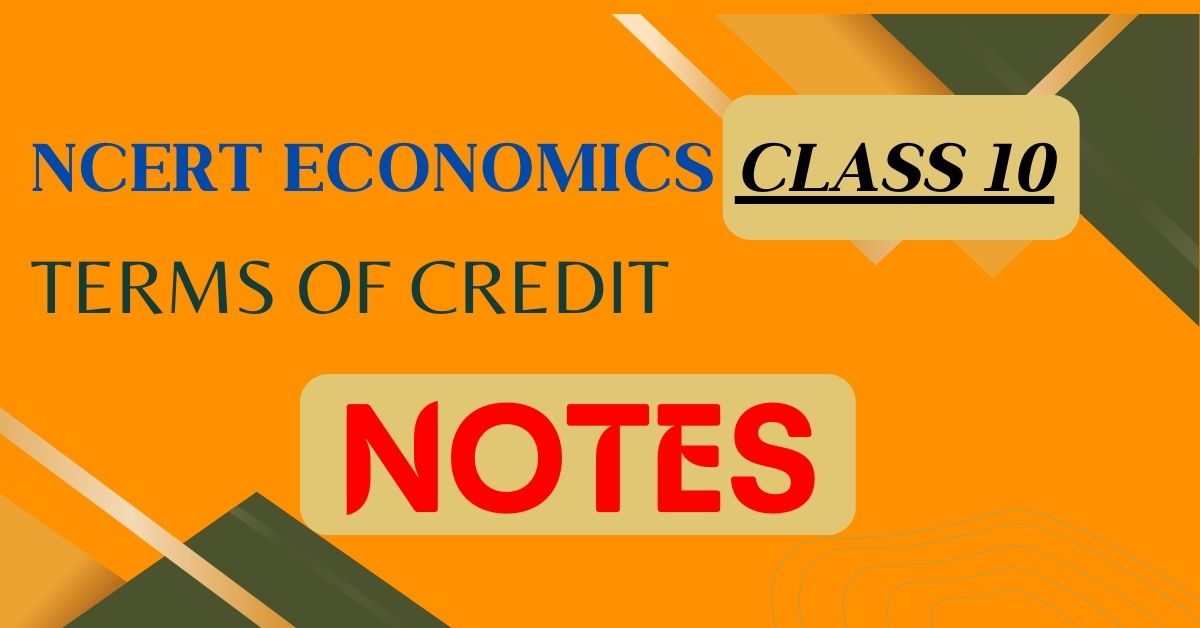NCERT Economics Class 10 | Terms of Credit Notes
Topic & sub-topics covered: Terms of Credit, Loans from Cooperatives: Money and Credit (All single detail notes are exam-oriented).
We have discussed in-depth and exam-oriented pointers that can be asked in the board exam of class 10th about “Terms of Credit, Loans from Cooperatives” which is taken from the NCERT Economics notes for class 10th chapter 3 “Money and Credit“.
Download the NCERT Economics for Class 10th Chapter 3 Money and Credit Notes PDF
Looking to grasp the concepts of money and credit in NCERT Economics for Class 10th? Look no further! Download the comprehensive Chapter 3 Money and Credit Notes PDF now and unlock a treasure trove of knowledge.
NCERT Class 10 Economics Chapter 3 Money and Credit Class 10th PDF Notes
Delve into the intricacies of monetary systems, explore the role of credit in the economy, and understand the mechanisms of banking and financial institutions. Our meticulously prepared notes provide concise explanations, illustrative examples, and insightful analysis to deepen your understanding of this crucial subject. With a clear focus on exam preparation and academic excellence, our PDF notes offer a structured approach to learning, helping you grasp complex concepts with ease.
Gain confidence in your knowledge and ace your exams with the help of our top-quality study material. Don’t miss out on this opportunity to elevate your learning experience – download the NCERT Economics for Class 10th Chapter 3 Money and Credit Notes PDF today!
Terms of Credit

1. Loan Agreement Components:
- Every loan agreement includes an interest rate to be paid along with the repayment of the principal amount.
- Lenders may also require collateral or security against loans.
2. Understanding Collateral:
- Collateral is an asset owned by the borrower, such as land, buildings, vehicles, livestock, or bank deposits, used as a guarantee to the lender until the loan is repaid.
- In case of loan default, the lender has the right to sell the collateral to recover the outstanding amount.
3. Examples of Collateral:
- Common examples of collateral include land titles, bank deposits, livestock, and other valuable assets.
4. Terms of Credit:
- Interest rate, collateral, documentation requirements, and repayment mode collectively constitute the terms of credit.
- These terms vary significantly depending on the lender, borrower, and specific credit arrangement.
5. Variation in Credit Terms:
- The terms of credit can vary widely across different credit arrangements, influenced by factors such as the nature of the lender and borrower.
Loans from Cooperatives
1. Cooperative Societies as Credit Sources:
- Cooperative societies serve as significant sources of affordable credit in rural areas alongside banks.
- They operate by pooling resources from members to offer financial assistance.
2. Types of Cooperatives:
- Different types of cooperatives exist, such as farmers’, weavers’, and industrial workers’ cooperatives, catering to specific needs.
3. Example: Krishak Cooperative:
- Krishak Cooperative, near Sonpur, comprises 2300 farmer members.
- It accepts member deposits, using them as collateral to secure loans from banks.
4. Utilization of Funds:
- Funds acquired by Krishak Cooperative are used to provide loans for various purposes, including purchasing agricultural implements, cultivation, agricultural trade, fishery activities, and house construction.
5. Loan Repayment and Continuation:
- After members repay their loans, the cooperative can initiate further lending, ensuring continuous financial support.
6. Role in Rural Development:
- Cooperatives like Krishak Cooperative play a vital role in rural development by offering accessible and cost-effective credit facilities to farmers and rural residents.
Next & Previous Topics of NCERT/CBSE Economics Class 10 Chapter 3: Money and Credit
FAQ
Q1. What are the terms of credit?
Answer: Terms of credit refer to the conditions and requirements associated with borrowing money or obtaining credit. These terms typically include aspects such as the interest rate charged on the borrowed amount, collateral or security required, documentation needed, and the mode of repayment.
Q2. What components are included in a loan agreement?
Answer: A loan agreement comprises an interest rate and may require collateral or security against the loan.
Q3. What is collateral, and how does it function?
Answer: Collateral is an asset owned by the borrower, serving as a guarantee for the lender until the loan is repaid. In case of default, the lender can sell the collateral to recover the outstanding amount.

